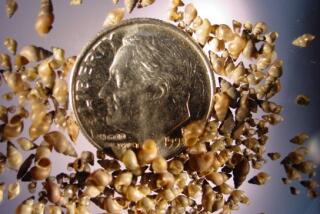Translucent snail discovered deep in a Croatian cave [Photos]
Deep in a Croatian cave, scientists have discovered a tiny snail with a shell that looks as if it is made of glass.
The Zospeum tholussum specimen was found more than half a mile beneath the Earth’s surface, in the Lukina Jama-Trojama cave system, one of the 20 deepest cave systems in the world.
The snail is minuscule -- just 1 millimeter across. It is part of a group of snails generally found along the drainage systems of caves. Like its Zospeum cousins, Zospeum tholussum has limited eyesight and mobility, according to researchers.
“Since they are grazing microorganisms from stones, mud and wood that has been washed into the cave, they have everything around that they need,” said Alexander Weigand of Goethe-University in Frankfurt, Germany, who described the snail in the journal Subterranean Biology.
Zospeum tholussum’s see-through shell is smooth and much more fragile than the shell of a snail you might find clinging to rocks at the ocean’s edge.
“At the beach, intertidal species have to cope with the pressure the water waves have on their shell -- it has to be very robust not to crack” Weigand explained. “In caves, however, there is no such need. Also, nutrients are poor, and evolving a thick, costly shell is a waste of energy.”
Adding pigment to the shell is also costly, and totally unnecessary in the darkness of the deep cave, he added.
Scientists exploring the cave in 2010 found just one living specimen of the snail in a chamber 0.6 miles beneath the Earth’s surface. The chamber was about 38 degrees Fahrenheit, had 100% humidity, and contained lots of stones, rocks and sand.
The researchers started collecting empty shells of the Zospeum tholussum half a mile into the nearly vertical cave and kept finding them even at the cave’s bottom, 0.86 miles below the surface.
If you click through the photo gallery above, you will find a graphic that shows the vertical nature of this cave, and the regions where the snail, and the shells, were found.
Return to the Science Now blog.





